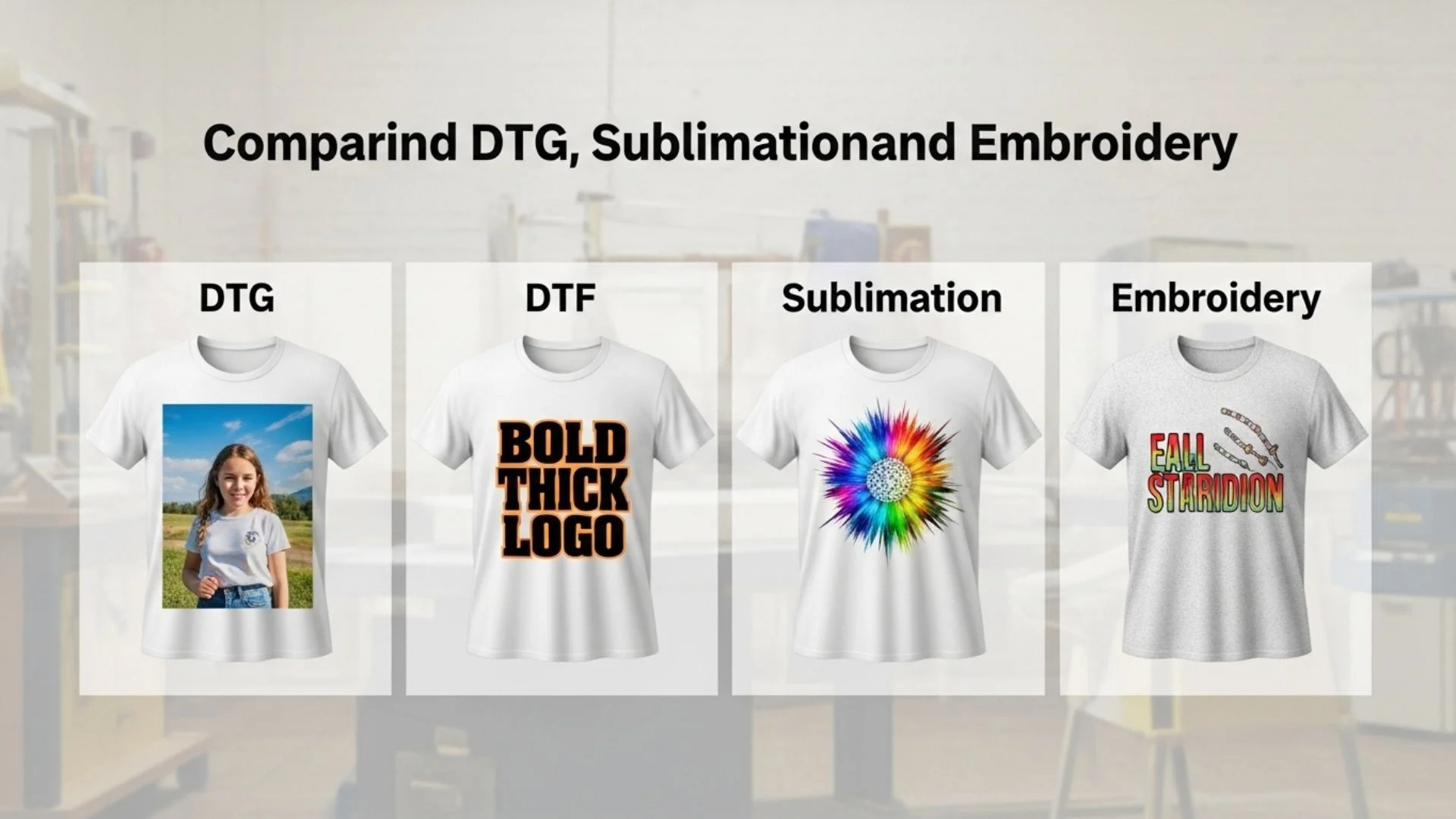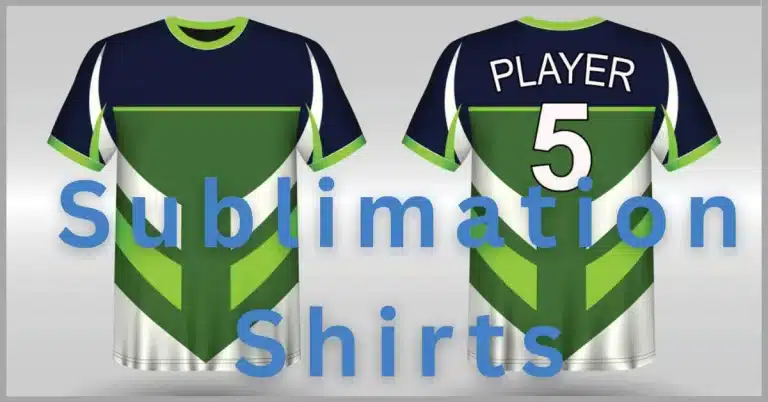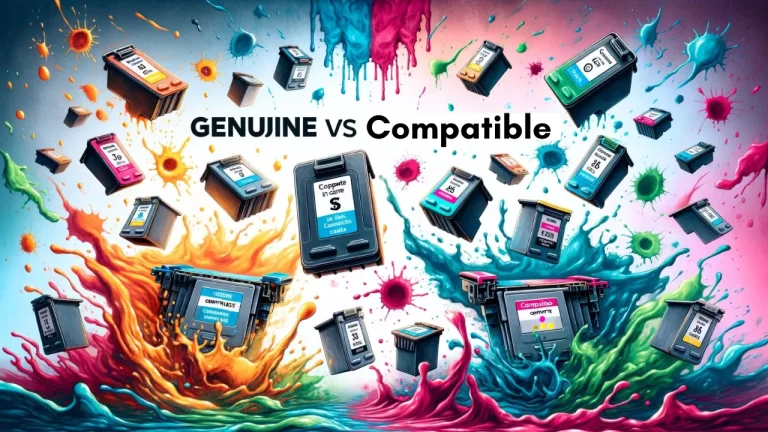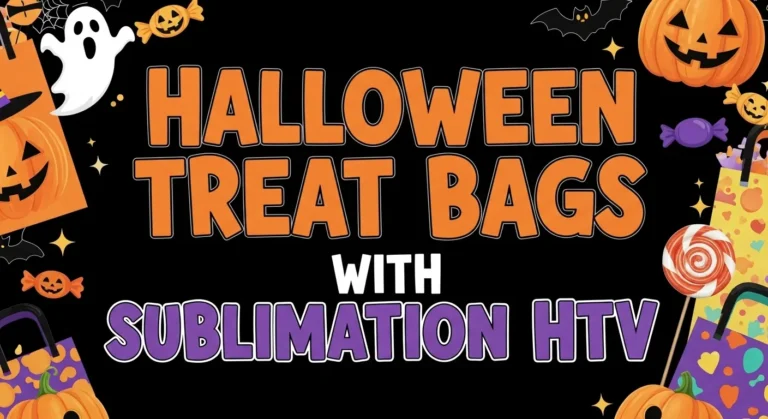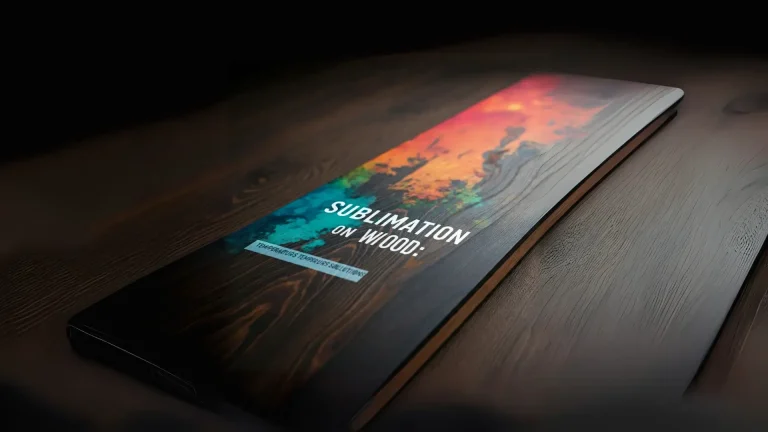Comparing DTG, DTF, Sublimation, and Embroidery
DTG prints directly onto cotton and other natural fibers, great for photo-like, short runs. DTF prints onto film then transfers to many fabrics, good for flexible small-batches and blends. Sublimation bonds ink into polyester or coated blanks for vibrant, permanent all-over prints.
Embroidery stitches thread for a durable, premium textured look. Choose by fabric, design type, and order size.
I’ll give a clear comparison table, practical examples, and short steps to pick the right method for your project. Read this if you want a fast, usable answer plus enough detail to explain your choice.
If you’re just starting out, our list of top 5 DTG printers for newbies can help you find an easy-to-use machine without overcomplicating your setup.
DTG (Direct-to-Garment)
- Prints ink directly onto fabric using a specialized inkjet.
- Best on high-cotton garments.
- Needs pre-treatment on dark garments to make whites pop.
Good for: photo-like prints, small runs, on-demand custom tees.
Limitations: not ideal for polyester-only items, slightly raised feel on dark shirts, can be slower for big batches.
DTF (Direct-to-Film)
- Prints full-color design onto a special PET film, powders it, then heat-presses the design to the garment.
- Works on cotton, polyester, blends, even some leather or nylon.
- Fast application and flexible substrate compatibility.
Good for: small to medium runs, mixed-fabric inventories, designs that need a thicker, durable print.
Limitations: thicker hand feel compared to sublimation or DTG, quality varies by powder and curing.
Sublimation
- Uses dye-sublimation inks that turn to gas under heat and bond with polyester fibers or specially coated hard goods (mugs, phone cases).
- Ink becomes part of the fabric — no extra hand-feel.
- Requires polyester or polymer-coated substrates; won’t work on uncoated cotton.
Good for: sportswear, vibrant all-over prints, promotional hard goods.
Limitations: needs polyester or coated substrates, color on dark fabrics is limited (usually works on white/light backgrounds unless using special techniques).
Check out more about Sublimation.
Embroidery
- A needle stitches thread into fabric to create a raised, textured design.
- Extremely durable and professional-looking for logos and text.
Good for: polos, hats, corporate uniforms, high-end branding.
Limitations: not ideal for photo-realism, fine detail or extremely small text, higher cost per piece on small orders.
Side-by-side comparison (quick table)
| Factor | DTG | DTF | Sublimation | Embroidery |
|---|---|---|---|---|
| Best fabrics | Cotton, natural fibers. | Cotton, polyester, blends, some synthetics. | Polyester or polymer-coated items only. | Thicker fabrics (polos, jackets, hats). |
| Look & feel | Soft on light garments, slightly raised on dark. | Thicker print body, slightly raised. | No hand, ink is part of fabric. | Raised, textured, premium. |
| Color/detail | Excellent for photos and gradients. | Very good color, bold solids. | Exceptional color on polyester; great for all-over. | Limited to thread colors, less for photo realism. |
| Durability | Good with care, may fade/crack over time. | Durable if properly applied and cured. | Very durable since ink bonds with fiber. | Most durable; resists washing/abrasion. |
| Best order sizes | One-offs to small runs | Small to medium runs | Medium to large, continuous production | Small to large, depending on design cost |
To see how DTG compares with another classic method, take a look at our DTG vs screen printing comparison covering durability, cost, and production speed.
Which to Pick: Common Scenarios
A local soccer club wants numbered, durable jerseys with sponsor logos, sublimation for full-color base and either embroidery or heat-applied logos depending on budget.
- You sell custom cotton tees, one-offs or low volumes: DTG is fast and gives photo-quality prints.
- You need prints across lots of fabric types (mix of cotton, blends, polyester): DTF gives flexibility and quick press application.
- You’re printing sports jerseys or all-over designs on polyester: Sublimation gives vivid, permanent color and no extra hand.
- You want a premium, logo-based uniform (polos, hats): Embroidery for a durable, upscale finish.
Real Production Cost Breakdown
Create a simple chart or table showing average cost per print (ink, consumables, labor, time) for each method.
| Method | Ink/Film Cost | Labor Time (per shirt) | Heat/Press Time | Avg Cost per Print |
|---|---|---|---|---|
| DTG | $1.50 | 4 min (print + cure) | — | $2.50–$3.50 |
| DTF | $0.80 | 2 min (print + powder) | 15–20 sec press | $1.50–$2.50 |
| Sublimation | $0.40 | 1 min (print) | 45 sec press | $0.80–$1.50 |
| Embroidery | — | 5–10 min stitching | — | $3–$8 (depends on stitches) |
🧮 Advanced Printing Cost & ROI Calculator
Compare DTG, DTF, Sublimation & Embroidery • Adjust inputs • See profits instantly
| Method | 🎨 Material Cost | ⏱ Labor (min) | 🧮 Total Cost | 💵 Profit | 📊 Margin % |
|---|---|---|---|---|---|
| DTG | $0.00 | $0.00 | 0% | ||
| DTF | $0.00 | $0.00 | 0% | ||
| Sublimation | $0.00 | $0.00 | 0% | ||
| Embroidery | $0.00 | $0.00 | 0% |
📈 ROI Calculator
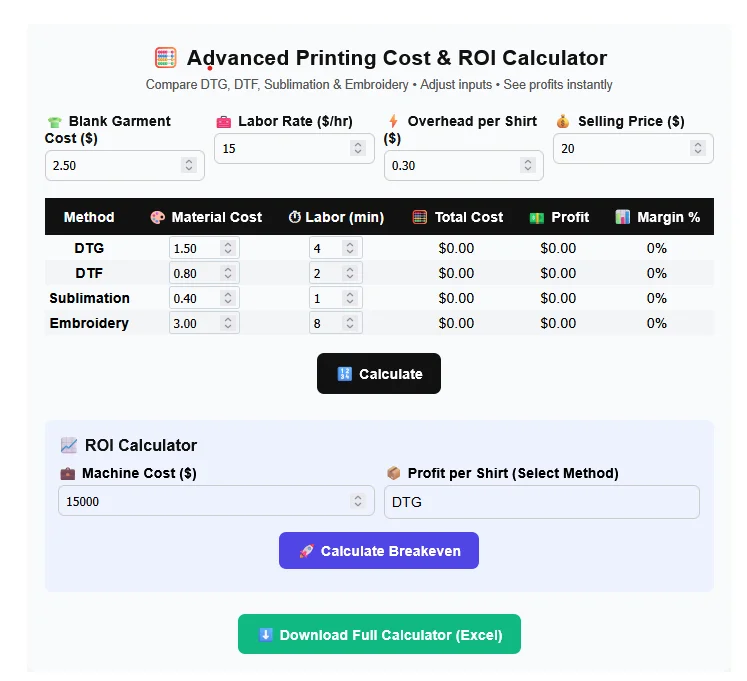
Speed Test: Shirt Throughput Per Hour
You can show how many shirts each method can produce per hour under typical shop conditions.
| Method | Prints per hour (1-person operation) |
|---|---|
| DTG | 10–20 (depends on design size) |
| DTF | 30–50 |
| Sublimation | 20–40 |
| Embroidery | 5–15 (depending on machine heads) |
Durability Score After 25 Washes
You could run a mini test (or use known benchmarks) and rate:
- Color retention (%)
- Cracking/peeling (visual score 1–5)
- Feel change (softness vs original)
| Method | Color Retention | Cracking Resistance | Overall Score |
|---|---|---|---|
| DTG | 75% | Medium | 3.5/5 |
| DTF | 90% | High | 4.5/5 |
| Sublimation | 100% | N/A (no layer) | 5/5 |
| Embroidery | 100% | N/A | 5/5 |
Environmental Impact Mini Chart
You can add estimated waste per print and energy use, even if approximate.
| Method | Ink Waste per Print | Power Use | Recyclability |
|---|---|---|---|
| DTG | High (pre-treat rinse + purges) | Medium | Limited |
| DTF | Low | Medium | Film not easily recyclable |
| Sublimation | Low | Medium | Paper recyclable |
| Embroidery | None | Low | Threads recyclable |
Consumer Perception Survey
We run a short poll on Instagram base asking things like:
“Which print method do you think looks most premium?”
“Which one do you prefer to wear after 10 washes?”
“Which one would you pay more for?”
The results in a chart like:
| Method | % Users Who Said “Premium Look” |
|---|---|
| DTG | 22% |
| DTF | 18% |
| Sublimation | 27% |
| Embroidery | 33% |
Pros And Cons Snapshot (So You Can Decide Fast)
DTG
- Pros: photo-detail, fast for single pieces, soft on light garments.
- Cons: best on cotton, slower for bulk, setup for dark shirts needed.
DTF
- Pros: works on many fabrics, quick press application, strong colors.
- Cons: thicker feel, quality depends on powder and curing.
Sublimation
- Pros: permanent color, no feel, ideal for polyester/all-over.
- Cons: only polyester/coated goods, not for natural cotton.
Embroidery
- Pros: very durable, premium look.
- Cons: not suitable for photo realism, can cause puckering on thin fabrics.
How to choose in 5 steps
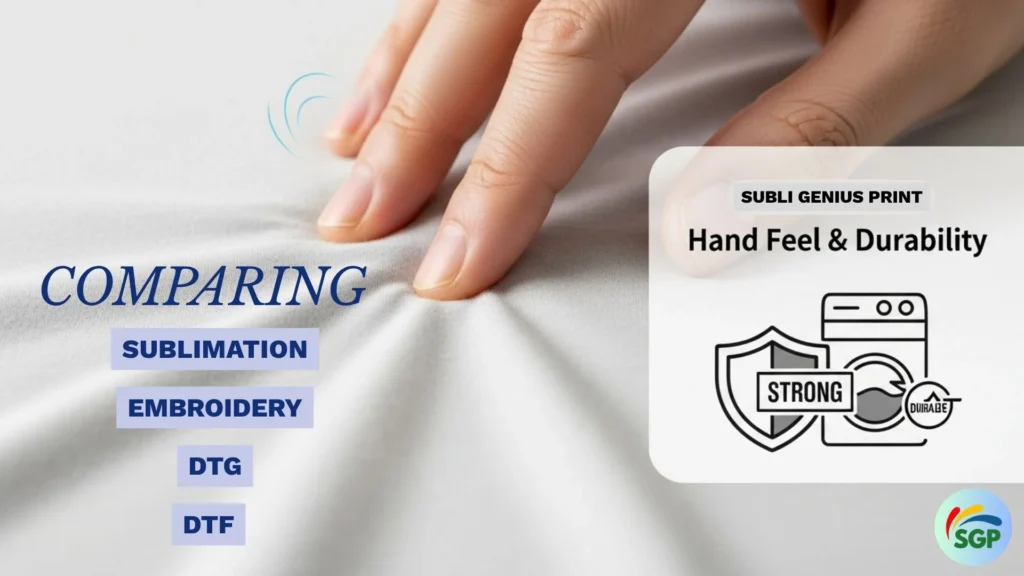
- Check fabric: polyester? consider sublimation. 100% cotton? DTG/DTF. Thick polo? embroidery.
- Define design type: photo vs vector vs text/logo. Photo = DTG/sublimation; vector/logo = DTF or embroidery.
- Decide batch size: one-offs = DTG; small runs with mixed fabrics = DTF; large polyester runs = sublimation.
- Consider hand feel & durability: want no feel = sublimation, want textured = embroidery, want bold thick prints = DTF.
- Test a sample: always run a sample under real wash conditions before committing.
Common misconceptions
- “DTG and sublimation are the same.” No. DTG deposits ink on fibers (works best on cotton), sublimation dyes polyester fibers so ink becomes part of the fabric.
- “Embroidery is always better quality.” Embroidery is more durable and looks premium for logos, but it can’t reproduce photorealistic art and raises per-piece cost.
Not sure which direct-to-garment machine fits your budget and goals? Our best DTG printers guide compares top options for different experience levels.
